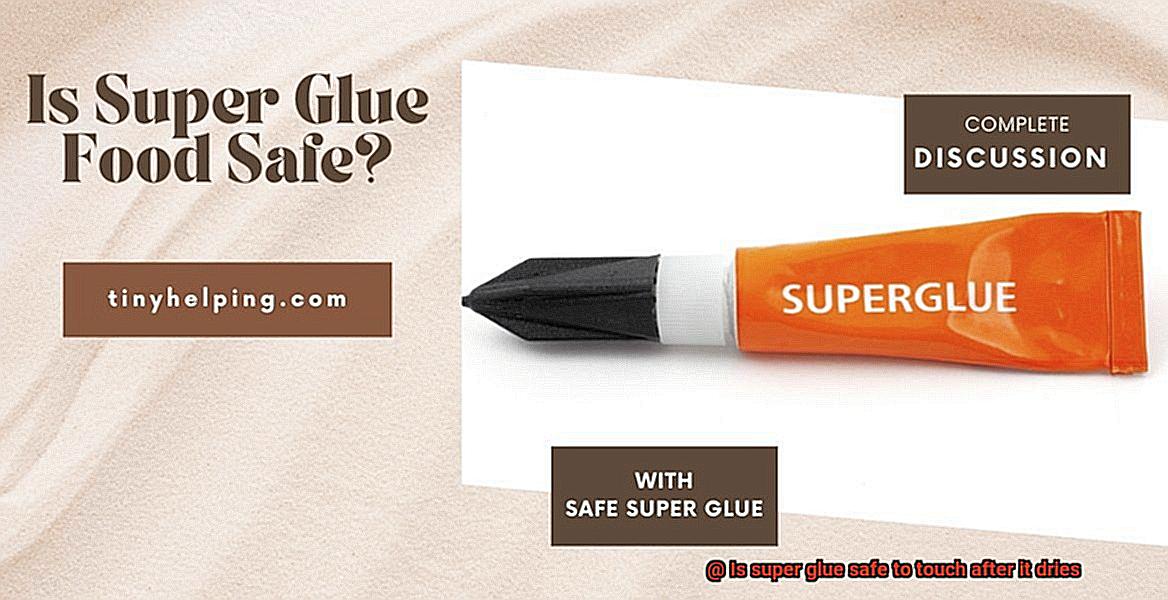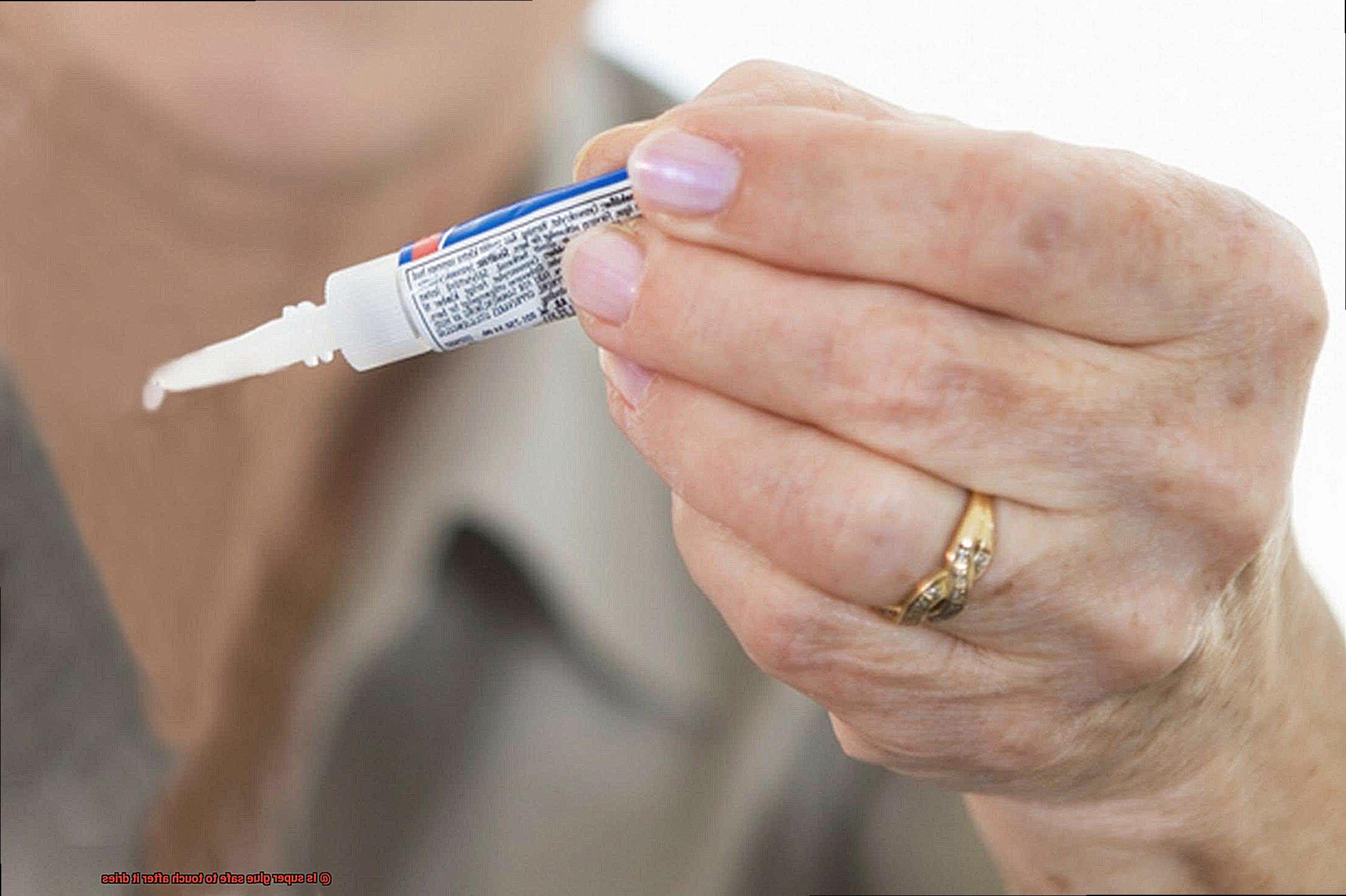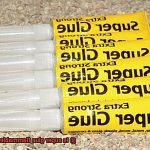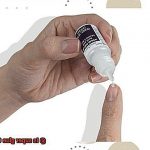Picture this: you’ve just wrapped up a DIY project, fixing that cherished ceramic vase or rescuing your go-to shoes with the help of trusty super glue. As the glue sets and hardens, a burning question arises in your mind: is it safe to touch now? This query has sparked countless debates and left DIY enthusiasts scratching their heads.
So, let’s dive into the nitty-gritty of whether touching dried super glue is a risk or not. Get ready for some myth-busting.
Is super glue safe to touch after it dries?
Contents
- 1 Is super glue safe to touch after it dries?
- 2 What is Super Glue?
- 3 How Does Super Glue Work?
- 4 Is Super Glue Safe to Touch After It Dries?
- 5 Potential Risks of Touching Dried Super Glue
- 6 Precautions for Handling Dried Super Glue
- 7 What to Do If You Accidentally Touch Dried Super Glue
- 8 Different Types of Super Glue and Their Safety Profiles
- 9 Conclusion
Risks of touching dried super glue:
Super glue contains a powerful adhesive called cyanoacrylate that works lightning-fast to bond surfaces together. While it may seem harmless once dry, touching dried super glue isn’t entirely risk-free. For some individuals, it can cause skin irritation or even trigger allergic reactions.
Prolonged or repeated contact might lead to redness, itching, or dermatitis. However, it’s worth noting that most people won’t experience any issues with occasional contact.
Benefits of touching dried super glue:
Despite the potential risks mentioned earlier, there are also benefits to consider when it comes to touching dried super glue. Firstly, it provides a quick and long-lasting solution for various household repairs. Being able to touch the dried glue allows you to check if the repair has set properly and make any necessary adjustments with ease. Moreover, its moisture-resistant properties make it perfect for fixing objects exposed to damp or humid conditions.
Tips for safe contact:
If you find yourself needing to touch dried super glue, taking precautions is crucial in minimizing potential risks. First things first, ensure that the glue has completely dried and hardened before laying a finger on it. Give it ample time because premature contact could compromise the bond and increase the likelihood of skin irritation.
Additionally, consider wearing protective gloves when handling super glue to avoid direct contact with your skin. If you do experience any adverse reactions, wash the affected area promptly with soap and water, and seek medical advice if necessary.
In conclusion, while it’s generally safe to touch super glue once it has dried, it’s important to be aware of potential risks, especially for those with sensitive skin or allergies. By taking necessary precautions such as allowing the glue to fully dry and using protective gloves, you can minimize the chances of experiencing any adverse effects. Remember, when in doubt
What is Super Glue?
Super glue, also known as cyanoacrylate adhesive, is a remarkable adhesive that packs a punch with its fast-acting and powerful bonding capabilities. Used in various industries and for everyday household purposes, this liquid resin is a go-to solution for creating strong and durable bonds between different materials. But what exactly is super glue and how does it work?
In this article, we will explore the wonders of super glue and how it can revolutionize your DIY projects and repairs.
Composition and Drying Process:
At its core, super glue consists of a cyanoacrylate monomer, a clear liquid that polymerizes rapidly upon contact with moisture. This unique composition allows super glue to bond surfaces almost instantaneously.
When exposed to air or moisture, the cyanoacrylate monomers undergo a chemical reaction that transforms them into a solid plastic-like material. Within seconds, the once liquid adhesive solidifies into a rigid bond that can withstand the test of time.
Versatility and Applications:
Super glue’s versatility knows no bounds. It can bond metals, plastics, ceramics, glass, and even some types of wood. Whether you’re repairing broken items like ceramic figurines or household appliances, or working on intricate jewelry making or model building projects, super glue is your trusty companion.
Its resistance to temperature changes makes it suitable for both indoor and outdoor use, ensuring that your bonds remain strong regardless of the environment.
Tips for Safe Handling:
While super glue is an incredible adhesive, it’s important to handle it with caution. Once dried, it forms a rigid bond that can be challenging to undo. To avoid unintended bonding or skin irritation, follow these safety precautions:
Wear gloves or use a barrier cream to protect your skin from direct contact.
If accidental contact occurs between dried super glue and your skin, wash the affected area with warm soapy water.
Different brands of super glue may have varying formulations and levels of irritants, so read and follow the instructions provided by the manufacturer.
How Does Super Glue Work?
Super glue, also known as cyanoacrylate adhesive, is a remarkable substance that swiftly and effectively bonds surfaces together. It starts as a liquid and magically transforms into a solid state in the blink of an eye, thanks to its main ingredient: cyanoacrylate.
When super glue touches a surface, it’s like unleashing a chemical reaction superhero. Even the tiniest bit of moisture, like the humidity in the air or the moisture on your skin, triggers its powers. The cyanoacrylate molecules in the glue come together and form long chains of solidified adhesive. This happens through an exothermic reaction, releasing heat as it solidifies. So don’t be surprised if you feel a slight warming sensation when using super glue. You might even see little bubbles forming as it dries – that’s carbon dioxide gas being released as a byproduct.
What’s truly amazing about super glue is its versatile bonding ability. It can stick to almost any material – plastic, metal, wood, glass, ceramics – you name it. It spreads quickly and fills every nook and cranny, creating a tight network of solid adhesive chains that form an unbreakable bond.
But beware. Once super glue dries and hardens, it becomes an incredibly strong adhesive that’s tough to remove. So handle it with care, especially on delicate or sensitive materials. Nobody wants their fingers glued together or accidentally bonding something they didn’t intend to.
Is Super Glue Safe to Touch After It Dries?
Super glue, or cyanoacrylate adhesive, has revolutionized bonding with its fast-drying and strong properties. But once it dries, is it safe to touch? The answer is generally yes, but there are important precautions to consider.
When super glue dries, it forms a robust bond that can withstand significant stress. This means that for most people, it is safe to touch. However, the safety of touching dried super glue depends on the specific brand and formulation. Some super glues are designed to be skin-safe and non-toxic, while others may contain potentially harmful chemicals. To ensure safety, carefully read the label and understand the manufacturer’s safety precautions.
If you accidentally get super glue on your skin, don’t panic. Immediately wash the affected area with warm soapy water to remove residue and minimize potential irritation. If washing alone is not enough, you can try using an acetone-based nail polish remover or a cyanoacrylate adhesive remover.
While touching dried super glue is generally safe externally, it should never be ingested or applied to open wounds or sensitive areas like the eyes or mouth. Ingesting super glue can cause stomach irritation and other adverse effects, while contact with sensitive areas can lead to severe irritation or injury.
To ensure your safety when using super glue, here are some important precautions to follow:
- Use in a well-ventilated area to avoid inhaling fumes.
- Avoid contact with skin, eyes, and mouth.
- Keep out of reach of children and pets.
- Store the glue in a cool and dry place to maintain its effectiveness.
Potential Risks of Touching Dried Super Glue
Super glue, also known as cyanoacrylate adhesive, is a versatile and widely-used adhesive known for its quick-drying and strong bonding properties. However, it is important to be aware of the potential risks associated with touching dried super glue. In this article, we will explore the various risks involved and provide you with essential information to protect yourself from these potential dangers.
Skin Irritation and Allergic Reactions:
Touching dried super glue can lead to skin irritation or allergic reactions, especially for individuals with sensitive skin or a history of allergies. Symptoms may range from mild redness and itching to more severe reactions such as blisters and swelling. It is crucial to consider your skin’s sensitivity and take appropriate precautions when handling dried super glue.
Chemical Burns:
The chemicals present in super glue have the potential to cause burns upon contact with the skin. The severity of the burn depends on factors such as the concentration of the glue and the duration of contact. Handling dried super glue with care and avoiding prolonged exposure can help minimize the risk of chemical burns.
Eye Damage:
Dried super glue poses a significant risk if it comes into contact with the eyes. Removing super glue from the eye can be challenging due to its adhesive properties, potentially causing damage to the cornea or other eye structures. Immediate medical attention is crucial if accidental eye contact occurs to prevent further complications.
Inhalation of Fumes:
Working with super glue in poorly ventilated areas increases the risk of inhaling its fumes. Inhaling these fumes can irritate the respiratory system, leading to symptoms such as coughing, shortness of breath, and throat irritation. To minimize exposure to these fumes, it is essential to work in a well-ventilated space or wear a mask when using super glue.
Accidental Ingestion:
While not common, accidental ingestion of super glue can occur, especially when working with small children or pets around. Ingesting super glue can cause gastrointestinal issues such as nausea, vomiting, and abdominal pain. In severe cases, it may lead to an obstruction in the digestive system, necessitating immediate medical intervention. Always keep super glue out of reach and ensure a safe working environment.
Precautions for Handling Dried Super Glue
Super glue is known for its strength and versatility, but once it dries, it can pose risks if not handled properly. In this article, we will explore the precautions you should take when handling dried super glue to ensure your safety. So, let’s dive in and learn how to handle dried super glue like a pro.
Avoid direct contact:
Dried super glue can be sharp and potentially irritate or cut the skin. To prevent any mishaps, avoid touching it directly. But if you accidentally come into contact with dried glue, don’t panic. Gently wash the affected area with warm soapy water and avoid forcefully peeling or pulling the glue off.
Use protective gloves:
To minimize risks, it is advisable to wear protective gloves when handling dried super glue. Opt for gloves made of latex or nitrile, as they provide a barrier between your skin and the glue, reducing the chances of any adverse reactions.
Clean tools and surfaces:
If you need to handle dried super glue on tools or surfaces, it’s crucial to clean them thoroughly before use. Residual super glue can be sticky and affect tool performance or cause objects to unintentionally stick together. Use acetone or nail polish remover to effectively remove any leftover glue.
Avoid excessive force:
When dealing with dried super glue, refrain from using excessive force to separate stuck objects or surfaces. Applying too much pressure can lead to breakage, damage, or injury. Instead, try applying a gentle twisting motion or using a blunt object like a plastic scraper to gradually loosen the bond.

Ensure proper ventilation:
Working with dried super glue in an enclosed space can release harmful fumes when inhaled. To prevent this, ensure your workspace has proper ventilation. If possible, work in a well-ventilated area or use a fan to circulate the air, keeping it fresh and safe to breathe.
Protect your eyes:
Accidental contact with dried super glue in your eyes can be dangerous. If this happens, immediately flush your eyes with water for at least 15 minutes and seek medical attention if necessary. Remember, prevention is key, so always wear protective eyewear when handling dried super glue.
Store properly:
To maintain the integrity of dried super glue and avoid accidental exposure, store it correctly. Keep it in a cool, dry place away from direct sunlight and out of reach of children and pets. Storing it in its original packaging or a sealed container will help prolong its shelf life and prevent any unwanted incidents.
What to Do If You Accidentally Touch Dried Super Glue
Super glue, also known as cyanoacrylate adhesive, is a fast-acting and powerful adhesive commonly used in various applications. Once super glue dries, it forms a strong and durable bond between surfaces. However, if you accidentally touch dried super glue, it can be uncomfortable and potentially dangerous if not handled properly. In this article, we will explore what steps you should take to safely remove dried super glue from your skin.
Remain calm and avoid panicking:
Accidentally touching dried super glue can be a frustrating experience, but it’s important to remain calm and avoid panicking. Panicking can lead to hasty actions that may cause further damage. Take a deep breath and approach the situation with a clear mind. Remember that there are steps you can take to safely remove the dried super glue.
Soak the affected area in warm soapy water:
The first step in removing dried super glue from your skin is to soak the affected area in warm soapy water for a few minutes. This helps to soften the dried glue and make it easier to remove. Gently massage the area with your fingers to loosen the glue. You can also use a soft cloth or sponge to help with the process.
Gently peel or roll off the glue:
After soaking, try gently peeling or rolling off the dried super glue using your fingers or a soft cloth. Avoid pulling or scraping forcefully, as this can potentially damage your skin or cause further irritation. If the glue does not come off easily, repeat the soaking process for a longer period of time and try again. Patience is key when dealing with dried super glue.
Use an acetone-based nail polish remover:
If soaking and gentle peeling do not work, you can try using an acetone-based nail polish remover. Apply a small amount of the remover onto a cotton ball or swab and gently rub it over the glued area. The acetone helps dissolve the adhesive, making it easier to remove.
However, be cautious when using acetone as it can cause dryness or irritation to your skin. Avoid excessive rubbing or prolonged exposure. It’s always a good idea to test a small, inconspicuous area of skin first to check for any adverse reactions.
Seek professional help if needed:
In some cases, if the glue is on a sensitive area of your skin or if you are unsure about how to safely remove it, it is best to seek professional help. Visit a doctor or dermatologist who can provide guidance and assistance in removing the dried super glue without causing any harm.
They may have access to specific tools or techniques that can safely remove the glue from your skin.
Different Types of Super Glue and Their Safety Profiles
Super glue, also known as cyanoacrylate adhesive, is a powerful bonding agent that can be found in many households. It is commonly used for various applications, from fixing broken objects to crafting projects. But once super glue dries, is it safe to touch?
There are several different types of super glue available on the market, each with its own unique properties and safety profiles. Understanding the differences between these types is crucial for using them effectively and safely.
Cyanoacrylate Adhesive
One common type of super glue is cyanoacrylate adhesive, known for its fast-drying and strong bonding capabilities. However, it can be quite strong and may cause skin irritation or allergic reactions in some individuals. It is recommended to avoid direct contact with the skin and to use gloves or protective barriers when handling this type of super glue.
Epoxy Resin
Another type of super glue is epoxy resin, which consists of two components that need to be mixed together before application. Epoxy resin generally has a lower risk of skin irritation compared to cyanoacrylate adhesive. However, it is still important to follow safety precautions and avoid prolonged or direct contact with the skin.
Specialized Formulations
Some super glues are specifically designed for use on sensitive materials such as fabric or foam. These types of super glue often have a milder formula that reduces the risk of damage or discoloration. They may also have lower fumes and odor, making them more suitable for indoor use.
When using any type of super glue, it is important to read and follow the instructions provided by the manufacturer. This includes wearing appropriate protective gear, such as gloves or goggles, and ensuring proper ventilation in the working area.
It is also important to consider the condition of the surface being glued. Super glue may not adhere well to certain surfaces, such as oily or dirty surfaces. Preparing the surface properly before applying the glue can help ensure a strong bond.
If accidental contact occurs between super glue and the skin, it is recommended to immediately rinse the affected area with warm soapy water. This can help remove any uncured glue and minimize potential skin irritation. Seeking medical attention may be necessary if the glue has bonded to the skin or if an allergic reaction occurs.
h1tbjyd2qjA” >
Also Read: What Temperature Does Super Glue Melt?
Conclusion
After super glue dries, it is generally safe to touch.
However, caution should still be exercised as there may be potential risks. Super glue forms a strong bond by creating a polymer chain reaction when exposed to moisture, which means it can stick to your skin and cause irritation or even burns.
Therefore, it’s important to avoid getting super glue on your skin in the first place. If you do happen to get it on your skin, don’t panic.
Avoid using harsh chemicals or forcefully pulling at the glued area, as this can cause further damage.






